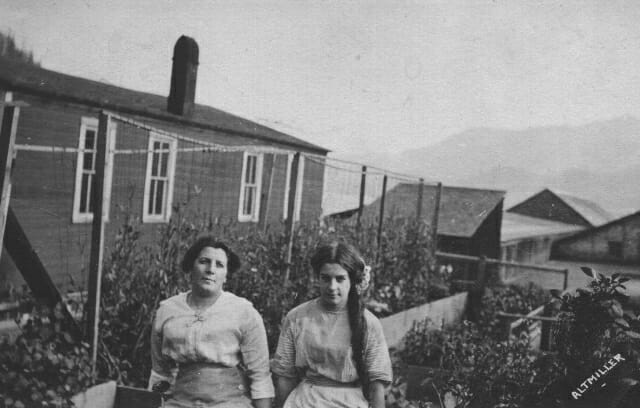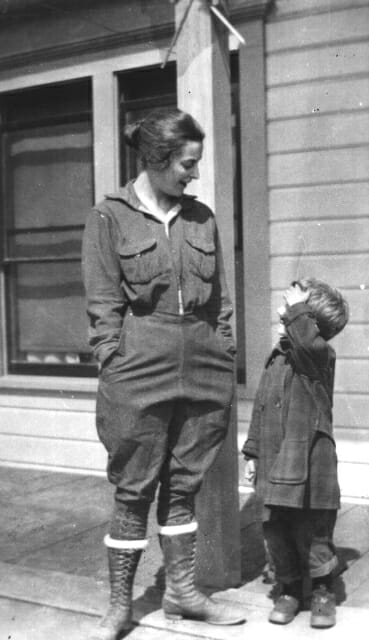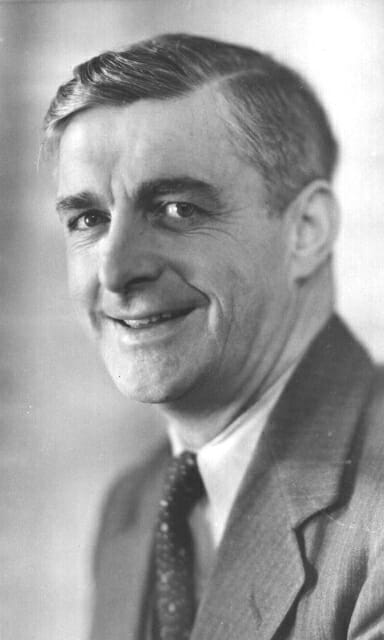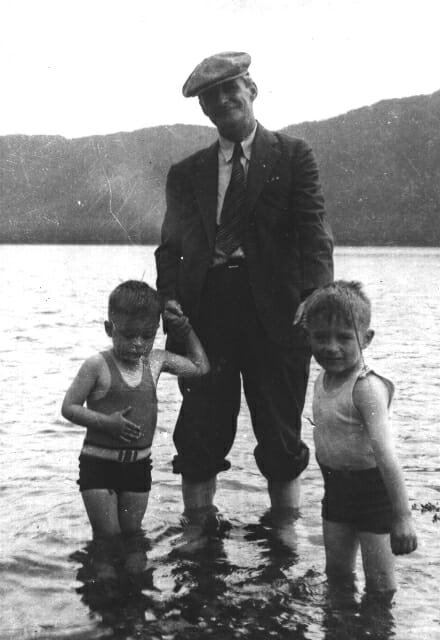Gastineau Channel Memories
Pegues
the Pegues brothers
The first member of the Pegues family to move to Alaska was our great grandfather Nicholas M. Haley, who was born in Ireland in 1839. He was married to Mary Ellen Donnigan Ryan, who was also born in Ireland, in 1841. They had five children who survived childhood: John, Edward J. (our grandfather who was born in Virginia City in 1865), Julia, Tom and Charlie. Nicholas died in Juneau in 1914, where he had come to seek medical attention, and he is buried in Evergreen Cemetery. Mary Ellen, an American Civil War nurse, died in 1921, and is buried in the National Cemetery in Sitka.
Nicholas Haley, an experienced miner from Grass Valley, California, and the Comstock, moved to Alaska with the U.S. Army in 1867, and apparently was present at the transfer from Russia. His family followed a year or two later. Whether by chance or design, (family tradition says he rejoined the Army after the Civil War in order to get to Alaska to mine), Haley became one of Alaska?s first hard rock miners.
In 1872, Nicholas discovered the Stewart Lode at Silver Bay, near Sitka, and he was involved in mining ventures in the Sitka area for the remainder of his life. According to Robert N. DeArmond, in a 1986 article in the Sitka Sentinel...? Nicholas Haley was, beyond all others, the father of Silver Bay mining...and he tried his best over a period of more than 30 years, to make it into a producer.? Alfred Hulse Brooks, in ?Blazing Alaska Trails,? states...? Haley was the first to recover gold from an Alaskan quartz gold mine. He did so by crushing the rich ore with aid of pestle and mortar.? A stamp mill soon followed! Of historic interest, Mary Ellen?s family piano, first transported to San Francisco via Cape Horn and then to Sitka, is on display at the Sheldon Jackson Museum.
The Haley children were raised in Sitka and attended Sitka?s first American school, the Presbyterian Mission School for Tlingits. As a consequence, they became well versed in Tlingit culture and fluent in the Tlingit language. To this day, Tlingit elders in Sitka recall the Haley family with special regard.
Haley?s second son, Ed, was our grandfather. He and his older brother John mined with their father at Silver Bay and were later joined by their younger brothers, Tom and Charlie. In 1888, Ed joined the U.S. Customs Service as Inspector Afloat aboard the passenger and mail steamer, George W. Elder. In 1892, he went to Yakutat to run the store and trading post that had been established by W.R. Mills. Subsequently, Ed was a miner in Juneau and also worked his own placer claims in the Pine Creek District near Atlin, B.C.
John Haley, Ed?s older brother, operated the ferry Julia on Gastineau Channel at the turn of the twentieth century. The Haley brothers also worked as commercial packers on the Chilkoot Trail to earn stakes for their own mining ventures, among them the Haley and Sons Mining Company.
The next member of the family to move to Alaska was our maternal grandmother, Edna Marion Sprague. Edna moved to Juneau in 1895, to teach school and to join her aunt and uncle, Matt and Alice Loughlin. She was born to Will and Mary Sprague, in Lyle, Minnesota, in 1875. She was raised on a farm near Perham, Minnesota. Edna and Ed Haley were married on July 7, 1896 in Juneau. She became a housewife after her two children, Dorothy and Donald, were born. In later years, she worked as a matron at the federal jail on Courthouse Hill. Edna accompanied Ed to his Pine Creek claims during the 1899 mining season and returned to Juneau late in the season, pregnant with Dorothy. Travel was by steamer and by foot over the Chilkoot Trail.
Edna?s second husband was Thomas G. Radonich. Tom was born in Dalmatia, on September 19, 1869. He came to the U.S. as a young man and first came to Juneau about 1891. He was an early Klondike stampeder and owned and operated a restaurant at Dawson City at the height of the gold rush. In Dawson, he was known as ?Carnation Tom? because, despite the difficulties of transportation over the Trail of ?98, he had regular shipments of fresh carnations brought in and always wore one in his lapel, a custom he followed for most of his adult life.
Tom returned to Juneau in the early 1900?s, and operated several businesses on Gastineau Channel including a restaurant, a meatmarket and gaming houses in Juneau and Douglas. Probably the best known of these businesses was the Alaska Grill, which for many years was the largest restaurant in Alaska. It was located on Front Street in the C.W. Young Building.
Tom was active in civic matters in those years and was a president of the board of trade, a forerunner of the chamber of commerce. He was also mainly responsible for instigating the league baseball series between Southeastern towns and Whitehorse, Y.T., and for a number of years he was manager of the Juneau Team. Tom worked until his death at the age of 87. He died after being struck by an automobile in Ketchikan. He is buried in Evergreen Cemetery.
Edna, the former Minnesota farm girl, maintained a large box garden on the rooftop of the C.W. Young Building, which was adjacent to her home above the Alaska Grill. In later life, she tilled an extensive terraced garden on the hillside above her final home on Basin Road. Tom built most of the terraces by hand. Edna was the first president of Pioneers Auxiliary No. 6. She died in 1951, and is buried in Evergreen Cemetery.
Edna?s uncle, Matt Loughlin, was chief mechanic at the Treadwell Mine. He and Alice had three daughters and one son; Garnet, Louella, Adelle and Ted. Adelle is fondly remembered as one of Juneau?s longtime telephone operators (central), Addie McKinnon. She had one son, the late Walter McKinnon. Addie?s sister Garnet Lahr died in 1996, in Seattle at the age of 101, and kept her home and garden on her own until her death.
Edna and Ed?s daughter, Dorothy Haley, was born in Juneau, on January 12, 1900. She graduated from Juneau High School in 1917, and attended the University of Washington. She was married twice. Her first husband was Douglas Austin, whom she married in 1925. She married her second husband John E. (Jack) Pegues in 1929.
Our father, Jack, was born in Tupelo, Mississippi, on September 28, 1887, and came to Alaska with General Billy Mitchell?s WAMCATS about 1910. He was a descendant of Claudius Pegues II, who was born in London in 1719, and migrated to Charleston, South Carolina, some years prior to 1749. Claudius II was the son of a French Huguenot, Claudius Pegues, and his Swiss wife, who had moved to England to escape religious persecution in France. Claudius II built his eventual American home, now known as Pegues Place, in 1760 (and rebuilt it in 1770 following a fire) on colonial land grants from Kings George II and George III. The home is still in the family and is the oldest existing house in Marlboro County, South Carolina.
Dorothy and Jack Pegues were pioneer Alaskan newspaper reporters, editors, and publishers. Their newspaper careers began in the mid-teens and ended in 1961. Dorothy began her career as a ?cub? reporter for E.J. ?Stroller? White at the Douglas Island News. Jack began his Alaska newspaper career with W.F. ?Wrong Font? Thompson at the Fairbanks Citizen, a predecessor to the Fairbanks News-Miner. Over the decades, Dorothy and Jack worked for a number of newspapers including the Daily Alaska Empire, the Alaska Sunday Press, the Anchorage Daily News, the Ketchikan Daily News, the Fairbanks Citizen, the Fairbanks News-Miner, Jessen?s Weekly, the Seattle PI and the New York World.
Jack Pegues moved to Juneau from Fairbanks in 1920, where he had been editor and manager of the Fairbanks Citizen to become the Empire?s city editor and for many years, thereafter, was the Empire?s managing editor.
In her early years in journalism, after reporting for the Daily Alaska Empire for two years, Dorothy Haley worked for an Anchorage newspaper for a short time, then in 1924, became the first publicity agent for the Alaska Railroad. The job was to promote tourist travel on the fledgling rail line, requiring her to travel to the Lower 48 for the better part of a year. She then returned to Juneau and the Empire. After her marriage to Jack Pegues, Dorothy spent most of her time in the 1930?s, raising their sons. After World War II, Dorothy was a coowner of the Miner Publishing Company, and she was the editor and publisher of the Alaska Sunday Press, a descendant of Stroller?s Weekly and the Douglas Island News. Dorothy worked several times for the Empire through the forties and fifties.
Dorothy was an astute political reporter and, in the newspaper profession, was known as a reporter?s reporter, covering every kind of news story. She had a well-deserved reputation for fairness and thoughtfulness and her sense of community values engendered public trust in her reporting. Dorothy also understood that while a newspaper had the duty to report about society?s evils, it also had the responsibility to report what was right and good, and she treated each with equal prominence. She never forgot her pioneer heritage and she shared her pride in those who came before and in those yet to come in her caring reporting of oldtimers who had passed on and when she reported on the successes of young people who would carry on the frontier traditions.
Jack was best known as an editor and editorial writer with a keen eye toward economic and political history, but he also reported his fair share of the news. A former Texas League shortstop, Jack was also a first rate sports writer and managed baseball teams during his early years in Juneau. He was also a longtime member of the Juneau Volunteer Fire Department.
In addition to Jack?s newspaper career, he was the NCOIC of the telegraph station in Eagle. Beginning in 1934, he served as Alaska Director for the National Emergency Council, including director of Federal Housing Administration in Alaska, during the administrations of territorial governors, John W. Troy and Ernest Gruening. Jack left government in the early forties and returned to journalism as managing editor of Jessen?s Weekly in 1943. He returned to Juneau in 1948, as an editorial writer for the Alaska Sunday Press. Jack died in 1949, and Dorothy died in 1961. They are both buried in Evergreen Cemetery.
Dorothy?s brother, Donald Sprague Haley, was born in Juneau on December 14, 1901. He married Bertha Ellen Brown, on October 7, 1929. Bertie was born on March 2, 1902, at Nanaimo River, B.C., and graduated from the nursing program at St. Joseph?s Hospital in Victoria in 1924. After graduation, she left almost immediately for Juneau to work at St. Ann?s Hospital as a surgical nurse. Bertie and Don had one daughter, Ellen Marion, who now resides in St. Albert, Alberta, with her husband Howard Sim. They have three grown sons. Together with other young men from Juneau, Don Haley was a member of the 1920?s crew that surveyed the Arctic Slope, leading to the establishment of the then Naval Petroleum Reserve No. 4. Don worked throughout Southeastern Alaska for many years prior to World War II, as a special warden for the U.S. Bureau of Fisheries and at one time operated the patrol vessel Auklet. In 1936, while based in Craig, Don chartered Bob Ellis and his float-equipped Waco to conduct fisheries patrols, the first time an aircraft was used for this purpose in the southern Panhandle. Don served in the U.S. Army during the early part of WWII and then he and Bertie moved to Ashford, Washington to log. He died in a logging accident on December 22, 1948, at Camp MacDonald near the foot of Mt. Rainier. After Don?s death, Bertie returned to Nanaimo and resumed her nursing career until she retired at age 65. She died in St. Albert on August 10, 1996.
Dorothy and Jack Pegues raised seven sons; Don (1926), Terry (1931), Rod (1932), Geoff (1934-1988), Bob and Dick (twins, 1936), and Bill (1939-1973). Despite all of the bumps, scrapes, fights, and the trials and tribulations that every boy experiences growing up (or perhaps because of them) all of Dorothy?s ?Thundering Herd? became solid citizens.
Don, like many of his contemporaries, spent his high school summers working for the Alaska Road Commission in Fairbanks and the Interior as a truck driver and heavy equipment operator, during the construction of the Alaska Highway and the reconstruction of the Richardson Highway, starting at age 15. He entered the U.S. Army following his high school graduation. After his discharge, Don went to work for Pan American World Airways, where he spent 32 years in a variety of assignments at Fairbanks, Juneau, Ketchikan/Annette, and Pago Pago, American Samoa. Although Don started in the trenches, most of his career at Pan Am was as a district traffic and sales manager and as country director for American Samoa, Western Samoa and Tonga. He was Pan Am?s Director for Alaska at the time of his retirement in 1978. Don is now general manager and a partner, with brothers Bob and Dick, in the Snyder Mercantile Company in Tenakee Springs. One of his duties at Snyder Mercantile is as a local agent for Wings of Alaska, giving Don more than fifty years in the airline business. He is married to Elsie Schombel of Haines and has four grown daughters.
Terry retired from the Alaska Department of Labor in 1999, after spending a long career as an employment and training program manager for the State of Alaska and tribal governments. He attended the University of Alaska and, as a young man, worked as a surveyor in the southeast, southcentral and interior regions of the State. Terry also spent several years in the Army National Guard and worked full time for the Guard in Juneau. He was a longtime radio sportscaster and sportswriter and was elected to the Gold Medal Hall of Fame in recognition of his many years of tournament broadcasting. Terry is married to June Brown of Angoon, and they have raised six children and one grandchild (hers, his, and theirs). Terry also has five other children from two previous marriages. He still works part time as an employment and training consultant and lives near the Douglas Highway.
Rod is a retired Alaska Superior Court Judge. He served in the U.S. Air Force as a Russian language expert and is a graduate of the University of Washington and the University of Washington Law School. Prior to his time in the bench, Rod was an assistant attorney general in Juneau. He was an assistant to the Chief of the National Park Service in Washington, D.C. and was Deputy Regional Director of the National Park Service for Region X, including Alaska, in Seattle. In this latter capacity, Rod was largely responsible for the creation of America?s part of the Klondike Gold Rush National Historic Park. He also served as the first director of the Local Affairs agency during Bill Egan?s first administration. Rod is married to Donna Spragg of Juneau, and has four grown children from a pervious marriage. Rod splits his time between his homes in Juneau and Borego Springs, California, and since his retirement has become a terror on the links!
Geoff, who died in 1988, was a Korean War era veteran and served most of his three year enlistment in the U.S. Army Security Service in Germany. He attended Western Washington University and the University of Alaska. Geoff spent most of his working years as a state employee in Juneau, Anchorage and Fairbanks. He started with the Department of Public Safety, later went to work for the Department of Highways and retired from the Department of Natural Resources as a land management officer in 1987. He was married to Sharon O?Toole of Tenakee Springs, and they raised four sons and one daughter. Now that Geoff is gone, it can be freely admitted that he had the best singing voice and was, by far, the best looking of all the ?Thundering Herd.?
Bob began a many-year career in radio and television when he was in high school and went to work as an announcer at KINY. He also worked at KJNO and KFAR Radio and TV in Fairbanks, where he worked variously as an announcer, news reporter, coanchor and co-director of KFAR News, and radio station manager. Bob was also network film director for the Midnight Sun Broadcasting Network, in Anchorage, back in the days when all of the TV programming in Alaska, except the local news, was broadcast from films. Bob moved to Tenakee Springs in 1963, and went to work for Dermott and Dorie O?Toole at Snyder Mercantile, and crab fished with Ryder Converse. Together with a group of other investors, Bob purchased the former Superior Cannery and adjoining lands, which he still holds. Commuting from Tenakee Springs, Bob also worked as an airport station operator during construction of the Trans-Alaska Pipeline system. After TAPS was completed, he was employed by Husky Oil as an airport controller at Camp Lonely, on the shore of the Arctic Ocean, during exploration of National Petroleum Reserve - Alaska. He later became assistant chief of Husky Oil?s Alaska Air Operations. Bob also worked as a controller in Exxon?s Spill Response Center in Valdez following the ?Exxon Valdez? oil spill. He served for several years on the Tenakee Springs City council, including three terms as mayor, and directed Tenakee?s disaster recovery efforts after the devastating 1984 Thanksgiving Day storm. Bob currently works for Snyder Mercantile, where he is a partner.
Dick retired in 1997, after a 25 year career as a state government administrator, including 21 years as the chief administrative officer for the Attorney General of Alaska. Prior to his state service, Dick worked for Pan American World Airways starting in 1960, as an operations representative in Fairbanks and later as airport manager in Taipei and Singapore. He also served as Pan Am?s Director of Operations for Singapore, Malaysia, and Brune until 1972, when he returned to Juneau, having maintained his Alaska residency. Dick also worked as a laboratory aide for the U.S. Bureau of Mines and a surveyor for the U.S. Bureau of Public Roads. Dick studied geology at the University of Alaska and since his retirement, has become a confirmed rock hound. He now works part time for Snyder Mercantile as a longshoreman, warehouseman, laborer, and stock boy. Dick is married to Josephine Hu Min-Hwa of Shanghai and Taipei and they have two grown daughters and a grown son.
Bill, the youngest member of the ?Herd,? worked as a surveyor and a radio announcer and, at one time, was news director at KJNO in Juneau. Bill was also a National Guardsman and was a unit caretaker for the Eskimo Scout Battalion in Bethel. In the late sixties, he became a partner in the Anchorage firm of Engineering Services, a job that took him from the Westward to the Bering Sea, the Arctic, and the Interior.
Bill died in 1973, at the completion of a hunting trip when the raft on which he and former business partner Howard Isberg were traveling upended, after striking a log jam near Shaw Creek on the Tanana River south of Fairbanks. Bill was then working at KFAR. At the time of his death, he and Isberg, who was thrown clear and survived the accident, were preparing to re-enter the engineering services business in Fairbanks. Bill was married twice and had one daughter. His sad death is the unfortunate price that is sometimes paid by those who knowingly go into Alaska?s real wilderness. This connection to the North Country is one Bill loved and the reason so many of us live here.
The other brothers, Jack and Jim were born in Fairbanks and moved to Juneau in 1920, when their father, Jack Pegues, became city editor at the Empire. They moved to Southern California in 1928, when their father and mother (Alice Maude Jedlika) were divorced.
Jack Pegues graduated from the University of Southern California?s School of Journalism and promptly went to work as a reporter for the San Francisco Chronicle. He was called up at the beginning of World War II and served as a line officer on LST?s and finished his military service as a Lt. Cmdr. Jack was present on the Battleship Missouri when General MacArthur accepted the Japanese surrender ending World War II. After the war, Jack returned to the chronicle and eventually became the chief editorial writer, before resigning in 1954, to join the New York Life Insurance Co. He returned to Juneau in about 1951 and again in 1954 in an unsuccessful attempt to purchase the Empire. He died unexpectedly in 1955, leaving a widow, Sue Bailey, and three small daughters.
Jim graduated from Santa Ana Junior College as a journalism major. His family?s wishes notwithstanding, Jim?s sights were set on a more practical, mechanical career. As a young man, Jim applied for one of a few jobs available at the Lockheed Aircraft Company near the end of the Depression. Fifty-three years later Jim retired as a Lockheed engineer. For many years he worked in Lockheed?s commercial aircraft division and spent nearly twenty years working for Kelly Johnson in Lockheed?s fabled ?Skunk Works.? He worked on the U2 and SR71 projects, and on the recently revealed D21 project, a pilotless supersonic drone. Jim is a widower. He was married to Maxine Mauck and they raised two daughters. Jim is a spry retiree and has visited Juneau nearly every summer since his retirement.
 |
Edna Sprague Roderick and daughter Dorothy Haley, 1912/14. |
 |
Dorothy Haley Pegues. |
 |
|
 |
|
